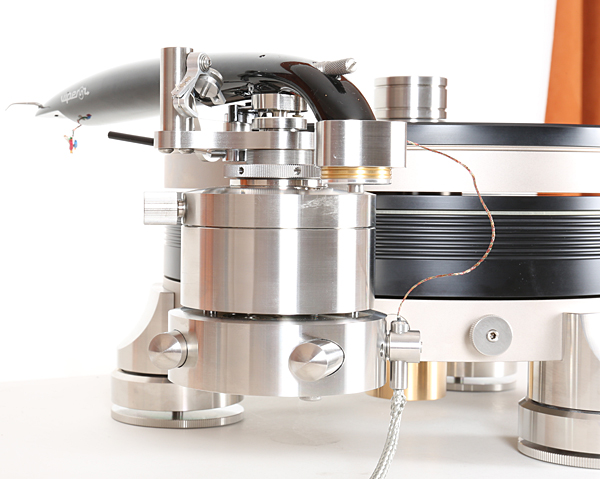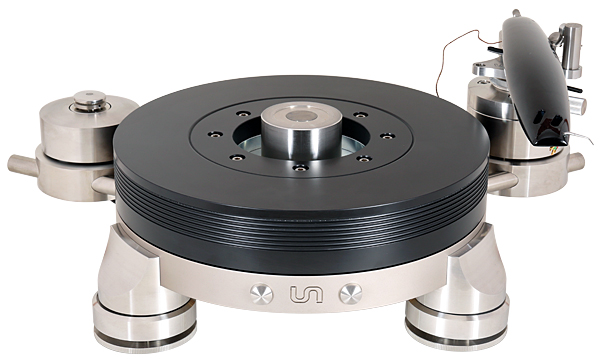Continuum Obsidian/Viper Turntable/Arm Page 2
![]() Swept Away
Swept Away
Fortunately, whatever reservations I had about the Viper and the price were swiftly swept away within seconds of the stylus touching down on the new pressing of James Taylor's Sweet Baby James in The Warner Brothers Albums 1970-1976 [Rhino R1 587550]. This LP is a feast of both acoustic and electronic instruments, sublimely recorded, but above all is that voice. If ever a singer exuded warmth and intimacy, it was Taylor circa-1970.

Brass Attack
With Air Tight's PC-7 moving-coil in place, the sound was rich but absolutely devoid of any unnecessary, overblown exaggeration. It was immediately apparent that the Continuum Obsidian/Viper duo was, with minimal exertion, in full control. This may prove a metaphorical stretch for some, but there's a direct link between the way this deck sounds and how it looks, feels and operates. By this I mean it is one of the simplest turntables you will ever use. Once used to handling the Viper – like all unipivot arms with a disconcerting 'free' feel – you note that the deck gets up to speed swiftly, responds to its controls without fuss and ignores airborne aggravation. What this did for the James Taylor tracks was to retain their delicacy without any compromise.
Amusingly, given that I started out with music relatively free of bombast, the next selection showed that the Obsidian could deliver power without any sense of restraint. Its dynamic capabilities perfectly suited the big band excess of my recently acquired, 'period' audiophile pressings, both for the power of the brass attacks and the weight of the bass. It was Ultimate Stereo Presentation [EMI Studio 2 Stereo TWO 3] and Bravo Brasso's kitschy if impressive cover of the Beatles' 'When I'm 64', which proved revelatory. If you ever see this in a charity shop, grab it: the tracks are spectacular, exemplified by this one, which really challenged the Obsidian.
Amazing Grace
The brass ran the gamut, but most revealing was the almost-comical tuba, deep, resonant and so authentic that I could only nod, too, in recognition of the capabilities of Wilson's Sasha DAW loudspeakers [HFN Mar '19]. For once, only the term 'visceral' will suffice.

Transient attack, clarity, textures – I was driven immediately to hear another contrast, the vocals from the recently departed Gregg Allman on 'Midnight Rider', a 45rpm 12in single from Analogue Productions [APP 123-45]. The Obsidian/Viper handled its aching, soulful interpretation with grace and refinement. Here, for a moment, it resembled the TechDAS Air Force III Premium, but the two still remained at some distance from each other.
Clearly, I needed a live set to complete the experience, and it was Cream's superbly-produced 2005 reunion, the 3LP set Live Royal Albert Hall London [Reprise 49416-1] that supplied the atmosphere and scale I needed to hear. I had forgotten how staggering was the sound and how blessed the performance – the delivery was dazzling.
Funky Edge
Side 3's 'Sweet Wine' provided a moment as telling as that of the tuba from Bravo Brasso. Even though the entire performance was a demonstration of all three players' prowess, it was Ginger Baker's behemoth percussion that exploited the control that turntables at this level possess. Again, it was a case of contrasts, the Obsidian/Viper not quite matching the absolute depths of the Air Force III Premium deck, but neither was it audibly diminished enough to force the choice.
Rather, it was the nature of the bass and the scale that differed enough subjectively to tip one's personal opinion. Regarding the former, the TechDAS turntable is slightly richer, with a bit more bloom and air. Conversely, the Continuum Obsidian/Viper had a funkier edge, and one can imagine a Mingus-worshipping jazz obsessive opting for the Obsidian.

As for the scale, both created unreservedly breathtaking soundscapes, but the sizes differed, attesting to the resolving powers of the rest of the system in the way they were revealed. The Air Force III placed the line of the sound slightly above that of the Continuum Obsidian, an odd effect I'd never detected before between decks.
The perceived stage depth was all but identical, but the TechDAS Air Force III's presentation was marginally wider. Yes, it really does get down to such picayune variances. But that's why you have to listen before you buy.
Hi-Fi News Verdict
So distinctive is the Continuum Obsidian/Viper's performance compared to other top-end decks that I've used that I'm being seduced by the cop-out that 'personal taste will be the determinant'. But that doesn't tell you the system delivers peerless retrieval of the bottom octaves, utterly realistic soundstage recreation and transparency that lets you hear exactly what's in the grooves.


















































